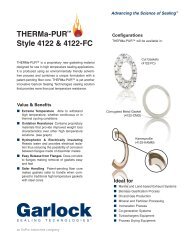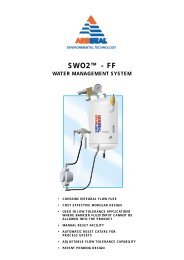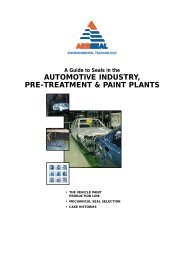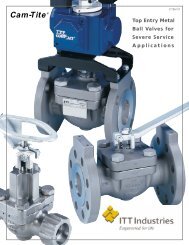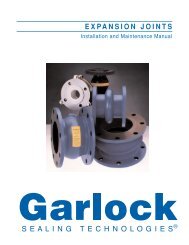PAPER RECYCLING PLANTS - AR Thomson Group
PAPER RECYCLING PLANTS - AR Thomson Group
PAPER RECYCLING PLANTS - AR Thomson Group
Create successful ePaper yourself
Turn your PDF publications into a flip-book with our unique Google optimized e-Paper software.
RREECCYCCLLEED PPAAPPEERR<br />
AESSEAL®<br />
<strong>PAPER</strong> <strong>RECYCLING</strong><br />
<strong>PLANTS</strong><br />
L-UK/US-RECYCLE-03<br />
IN 4540 - 02/2002<br />
20<br />
© Copyright 2002 AESSEAL plc All Rights Reserved.<br />
By Vendor By Purchaser<br />
API PLAN NO.32<br />
Flush injected from an<br />
External Source.<br />
The water source for Plan 32 should be as clean as possible, however recycled filtered<br />
process water is often successfully used for this purpose.<br />
Pulp plants are extremely resistant to increasing their process water consumption, therefore<br />
towns/utility water supply is rarely a viable alternative. Even recycled water is important to the<br />
user and the flush flow is often controlled using variable orifice flow meters.<br />
Using quench water alone on ENCLOSED boxes is not a solution to the problem of blocking<br />
on the product side. The seal faces will probably not "burn" out but severe erosion of the<br />
rotary will take place.<br />
OPEN STUFFING BOX DESIGN<br />
VORTEX BREAKER<br />
EROSION POSSIBLE<br />
The seals face a different problem with open boxes i.e. if not correctly designed, severe<br />
erosion can take place at the gland. Clogging is no longer an issue but it is often prudent on<br />
higher pulp concentrations (>2%) to use a quenched seal, thereby preventing the blockage of<br />
the internal/spring cavities of the seal (atmospheric side), which would eventually lead to<br />
seizure of the seal rotary causing severe leakage of product.



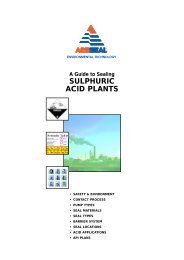
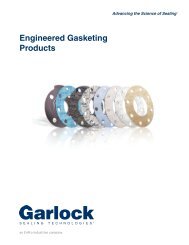
![VCS Flange Gasket [1.03 MB] - AR Thomson Group](https://img.yumpu.com/12044617/1/190x245/vcs-flange-gasket-103-mb-ar-thomson-group.jpg?quality=85)

![PGE Flange Gasket Product Brochure [1.04 MB] - AR Thomson Group](https://img.yumpu.com/12044595/1/190x245/pge-flange-gasket-product-brochure-104-mb-ar-thomson-group.jpg?quality=85)
